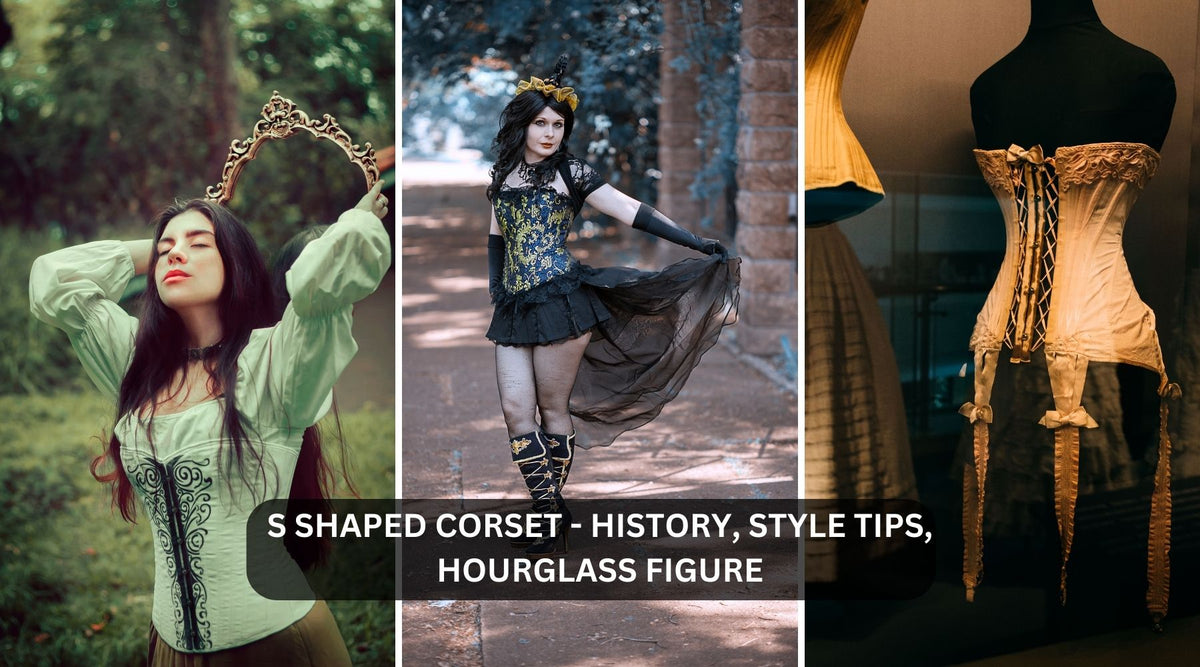
S shaped corset - Know Everything History, Style Tips, Hourglass Figure
|
|
Time to read 4 min
|
|
Time to read 4 min
The S-shaped corset, recognized as the S-bend corset, gained significant popularity in late 19th and early 20th-century fashion. It was designed to create a specific silhouette for women, emphasizing an exaggerated S-shaped curve.
The S-bend corset introduced a new silhouette that pushed the bust forward and the hips backward, creating a distinctive "S" curve when viewed from the side.
To achieve this shape, the S-shaped corset had a straight, rigid busk in the front to flatten the abdomen and force the chest forward. It also had a curved, padded bustle in the back, which pushed the hips back and created a swayback effect.
The waist was still cinched, but the emphasis shifted to the upper and lower parts of the body, creating a more extreme hourglass figure.
The S-shaped corset was promoted as a healthier option, asserting to alleviate pressure on the abdomen and internal organs. However, it still restricted movement and could potentially cause discomfort and health issues.
Over time, the S-shaped corset fell out of fashion as women sought more freedom and comfort in their clothing. Nowadays, corsets are primarily worn as fashion statements or for specific purposes like waist training, rather than for everyday wear.
The S-curve silhouette, popular from the late 1890s to the 1910s, was achieved through the use of the S-bend corset.
This fashion trend emphasized an exaggerated hourglass figure, with a pushed-forward bust and a pushed-back rear. Women of different social classes embraced this style, seeking to conform to the fashionable ideals of the era.
Fashion magazines and corsetieres played a significant role in promoting and shaping S Shaped corset. Throughout the 1910s, there was a notable shift in fashion towards a more natural and relaxed silhouette, a change expedited by the outbreak of World War I.
The S-curve era marked a significant chapter in women's fashion, reflecting the evolving ideals and societal influences of the time.
The S-bend corset gained fame in the late 19th and early 20th centuries for multiple reasons.:
The S Shaped corset made a cool and different shape compared to old Victorian corsets. The exaggerated S-curve emphasized a small waist, pushed the bust forward, and accentuated the hips, creating an extreme hourglass figure that was considered fashionable during that time.
Artistic movements such as Art Nouveau and the Belle Époque were prominent during the late 19th and early 20th centuries. These movements celebrated curves, sensuality, and natural forms.
The S-bend corset shape resonated with these artistic ideals, making it popular among women who wanted to embody the fashionable aesthetic of the time.
The S Shaped corset was marketed as a healthier alternative to previous corsets. It claimed to alleviate some of the health issues associated with tight-lacing, such as restricted breathing and organ compression.
The design of the s bend corset, with its forward-thrusting bust and pushed-back hips, was believed to promote an "uplifted" and more natural posture.
The endorsement of influential figures, such as fashion designers, actresses, and socialites, played a significant role in popularizing the S-bend corset.
Women looked to these figures as style icons and sought to emulate their fashion choices, including wearing the S Shaped corset.
The prevailing social norms and ideals of the time placed importance on a specific feminine ideal, which included a small waist and an exaggerated hourglass figure.
The S-bend corset allowed women to conform to these ideals and be seen as fashionable and attractive within their social circles.
The S Shaped corset's popularity faded as women sought comfort and freedom in clothing. The corset became associated with restrictive and unhealthy practices, leading to a shift in fashion and the eventual decline of corsets as everyday undergarments.
Yes, there are different types of corsets that vary in terms of style, design, and purpose. Here are some of the common types of corsets:
Victorian Corsets:
Back in the Victorian days, corsets were a big deal. They made women's waists small and their figures look super curvy.
Victorian corsets were typically made with sturdy materials like whalebone or steel boning and were laced tightly at the back to cinch the waist.
They extended from the bust to the hips, providing support and shaping to the entire torso.
Underbust Corsets: Underbust corsets, as the name suggests, cover the area below the bust and extend to the hips. They are versatile and can be worn over a blouse, dress, or even as foundation garments.
Underbust corsets provide waist shaping and support to the lower torso without restricting the bust. They are popular for creating a defined waistline and can be worn as part of both historical and contemporary fashion.
Overbust corsets cover the entire torso, including the bust. They provide support to the breasts while cinching the waist and accentuating the hourglass figure.
Overbust corsets can be worn as standalone tops or incorporated into various outfits. They come in different styles, such as sweetheart neckline, halter neck, or with shoulder straps, offering a range of aesthetic options.
Waist Cinchers: Waist cinchers, also known as waist trainers or underbust corset belts, are shorter corsets that focus primarily on cinching the waist. They typically cover the area from just below the bust to the upper hips.
Waist cinchers are often made with flexible materials like PVC or spandex, allowing for greater movement and comfort. They are commonly used for waist training, where the gradual reduction of the waist size is desired.
Note that within each type of corset, there can be further variations in design, closure methods (such as laces, hooks, or zippers), and materials used. Corsets have evolved over time to cater to different fashion trends, functionality, and personal preferences.